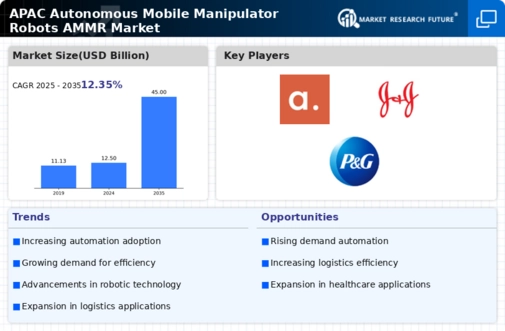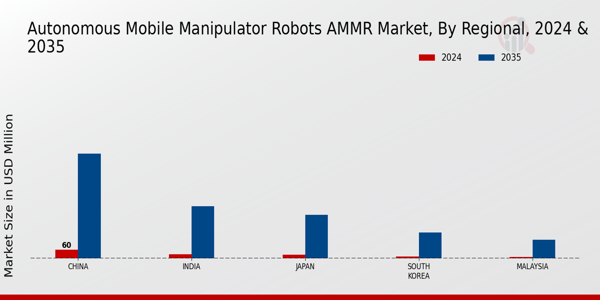Increased Labor Costs
The Global APAC Autonomous Mobile Manipulator Robots AMMR Market Industry is significantly influenced by rising labor costs across the region. As wages increase, businesses are compelled to seek automation solutions to maintain competitiveness and profitability. Autonomous mobile manipulators offer a viable alternative to traditional labor, enabling companies to reduce operational costs while improving efficiency. This trend is particularly evident in sectors such as warehousing and logistics, where labor shortages are becoming more pronounced. The market is anticipated to grow at a CAGR of 12.35% from 2025 to 2035, driven by the need for cost-effective automation solutions that address labor challenges.
Growing E-commerce Sector
The expansion of the e-commerce sector is a key driver for the Global APAC Autonomous Mobile Manipulator Robots AMMR Market Industry. As online shopping continues to gain traction, logistics and fulfillment operations are under pressure to enhance efficiency and speed. Autonomous mobile manipulators are increasingly deployed in warehouses and distribution centers to streamline order fulfillment processes. This trend is expected to contribute to the market's growth, with estimates suggesting a rise to 45 USD Billion by 2035. The integration of these robots into e-commerce operations not only improves productivity but also enhances customer satisfaction by ensuring timely deliveries.
Market Growth Projections
The Global APAC Autonomous Mobile Manipulator Robots AMMR Market Industry is poised for substantial growth, with projections indicating a market size of 12.5 USD Billion in 2024 and a remarkable increase to 45 USD Billion by 2035. This growth trajectory suggests a compound annual growth rate (CAGR) of 12.35% from 2025 to 2035. The increasing adoption of automation technologies across various sectors, coupled with advancements in robotics, is likely to drive this expansion. As industries recognize the value of integrating autonomous mobile manipulators into their operations, the market is expected to flourish, reflecting a broader trend towards automation in the APAC region.
Technological Advancements
Technological advancements play a pivotal role in shaping the Global APAC Autonomous Mobile Manipulator Robots AMMR Market Industry. Innovations in artificial intelligence, machine learning, and sensor technologies are enhancing the capabilities of mobile manipulators, allowing them to perform complex tasks with greater precision. These advancements not only improve operational efficiency but also expand the range of applications for these robots. As the technology matures, the market is expected to grow significantly, with projections indicating a rise to 45 USD Billion by 2035. This evolution in technology is likely to attract investments and drive further research and development in the field.
Rising Demand for Automation
The Global APAC Autonomous Mobile Manipulator Robots AMMR Market Industry experiences a surge in demand for automation across various sectors, including manufacturing, logistics, and healthcare. As industries strive for efficiency and cost reduction, the adoption of autonomous mobile manipulators becomes increasingly attractive. In 2024, the market is projected to reach 12.5 USD Billion, reflecting a growing recognition of the benefits these robots offer. Companies are investing in automation technologies to enhance productivity and streamline operations, suggesting a robust trajectory for the market. This trend is likely to continue as organizations seek innovative solutions to meet evolving consumer demands.
Focus on Safety and Compliance
Safety and compliance considerations are becoming increasingly prominent in the Global APAC Autonomous Mobile Manipulator Robots AMMR Market Industry. As industries adopt automation technologies, ensuring the safety of both workers and equipment is paramount. Autonomous mobile manipulators are designed with advanced safety features, reducing the risk of accidents and enhancing workplace safety. This focus on safety is likely to drive adoption rates, as companies prioritize compliance with regulations and standards. The market's growth is expected to be robust, supported by the increasing emphasis on creating safer working environments through the integration of autonomous technologies.














